
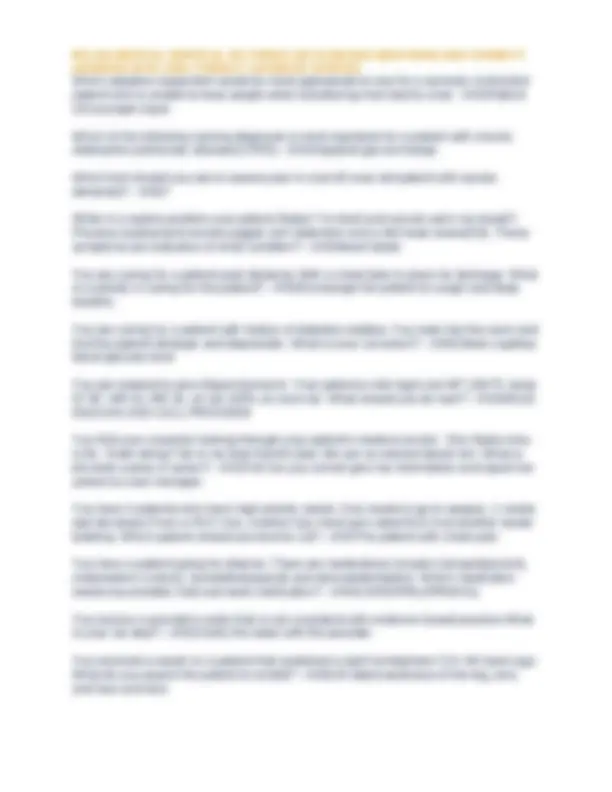
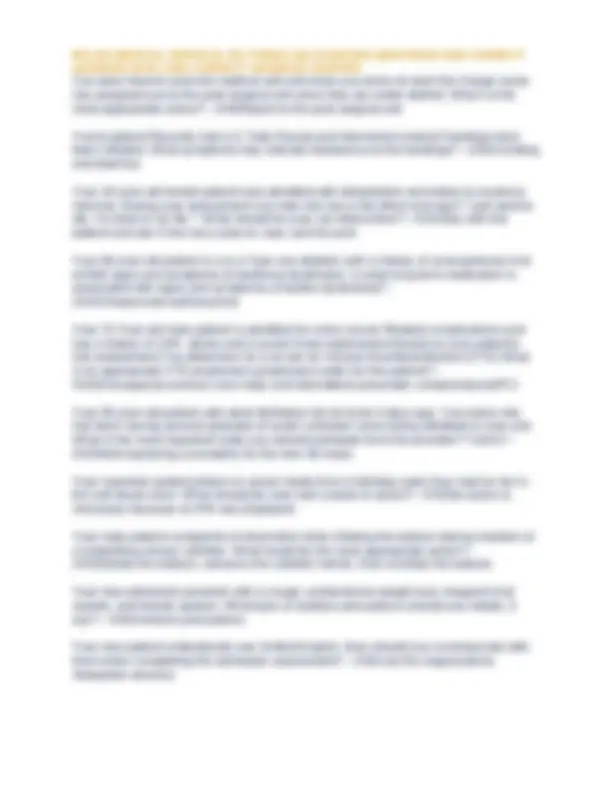
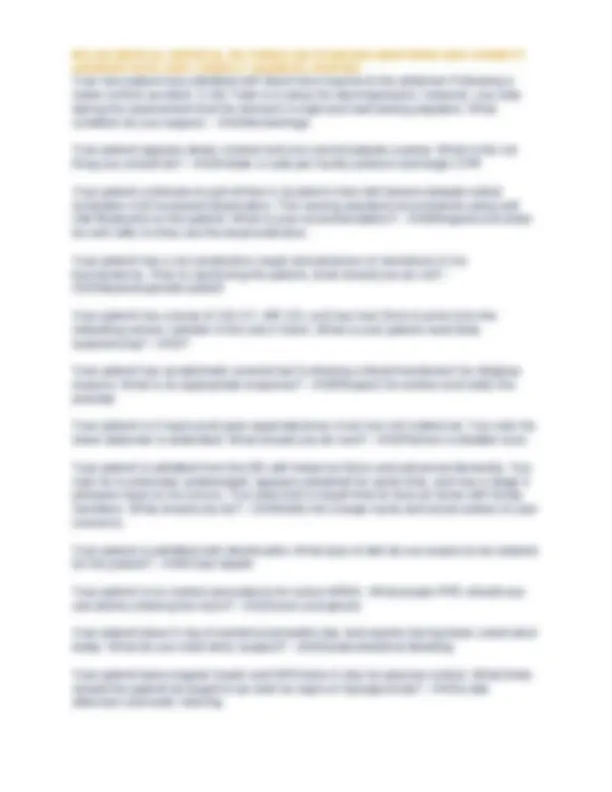
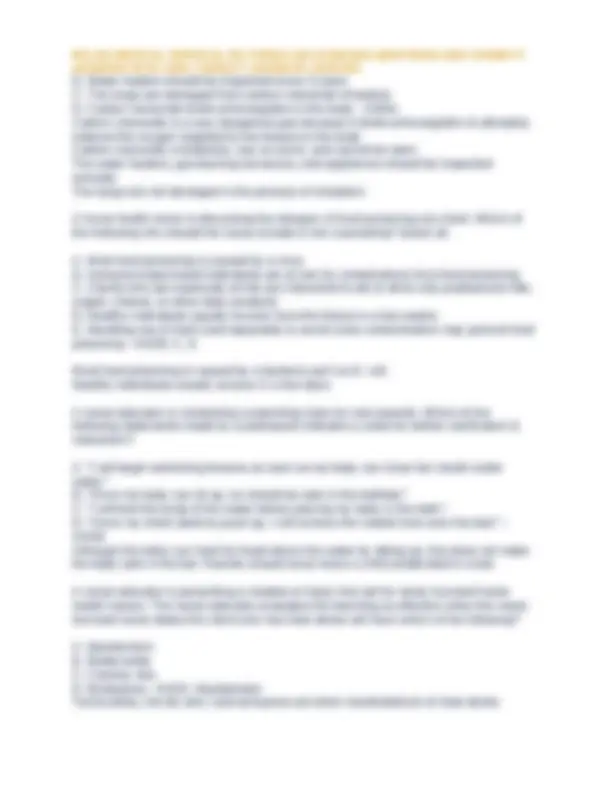
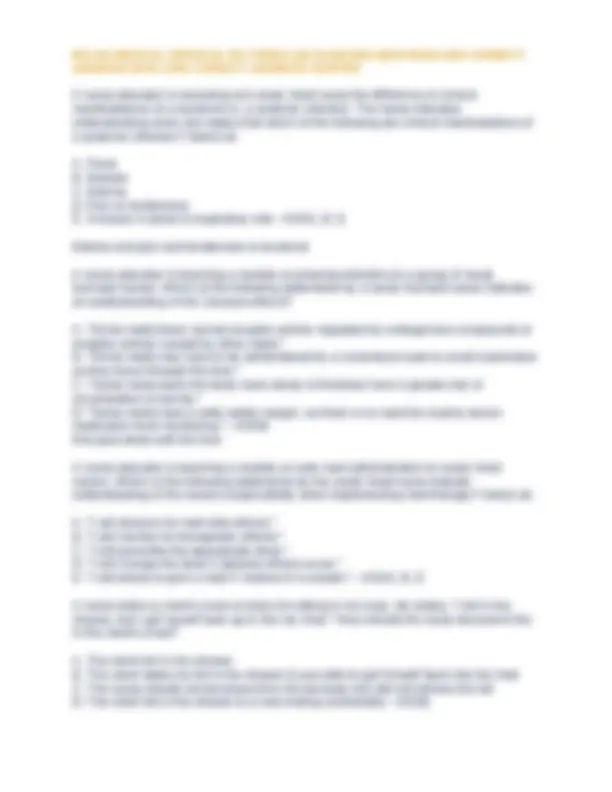
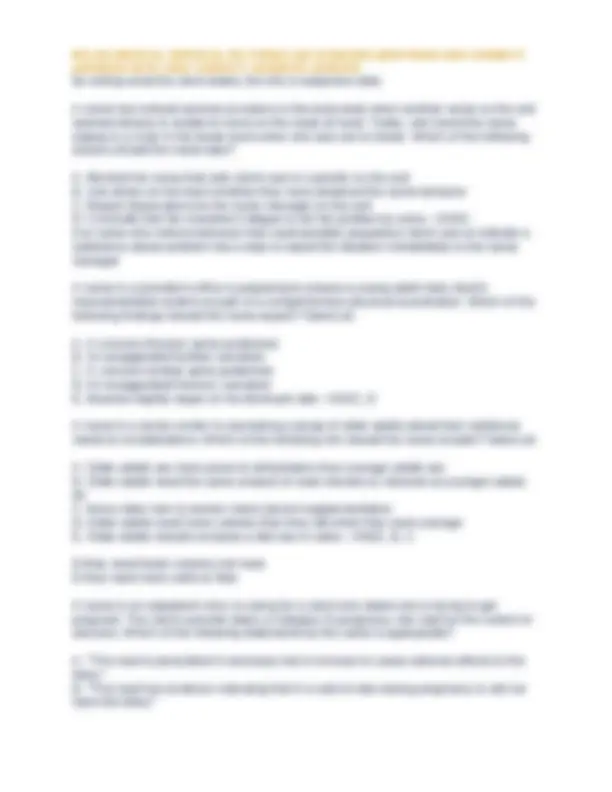
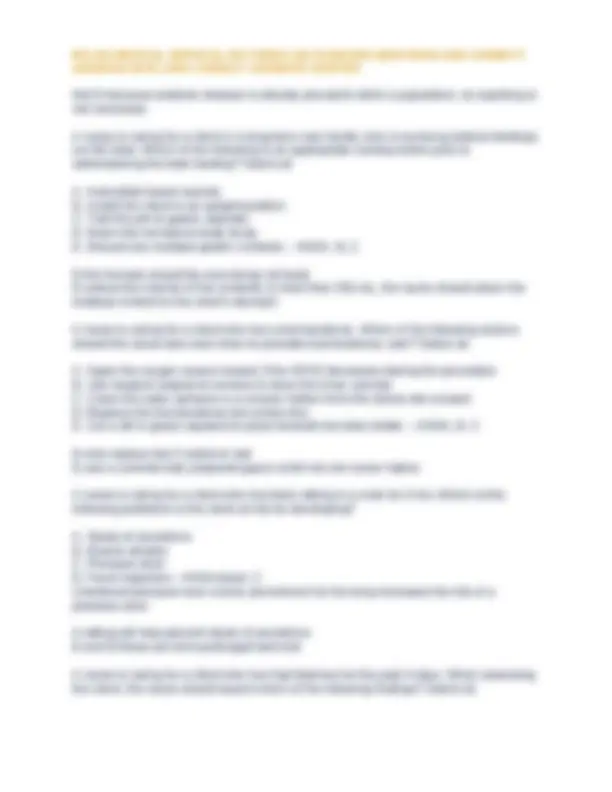
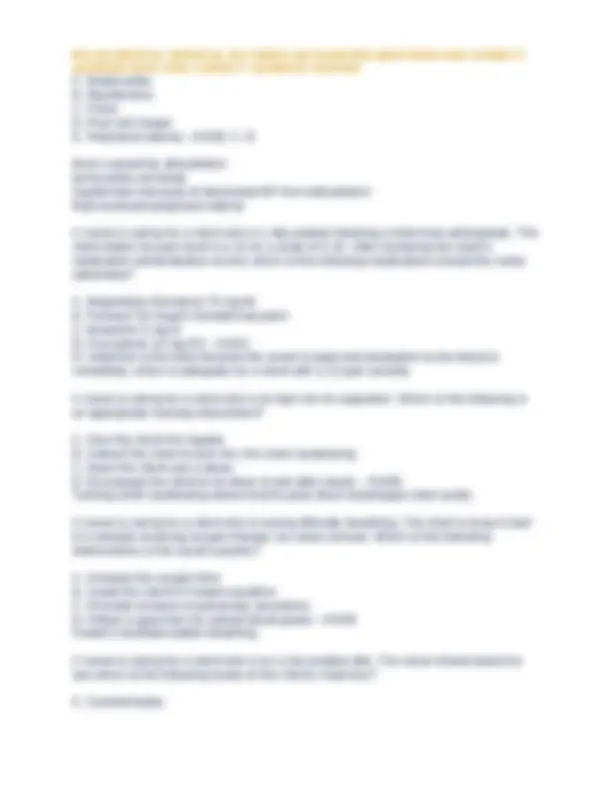
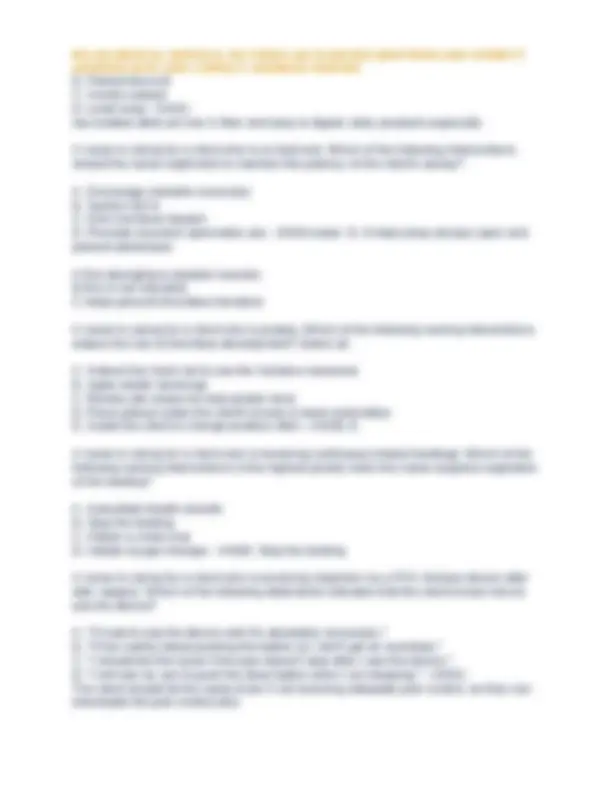
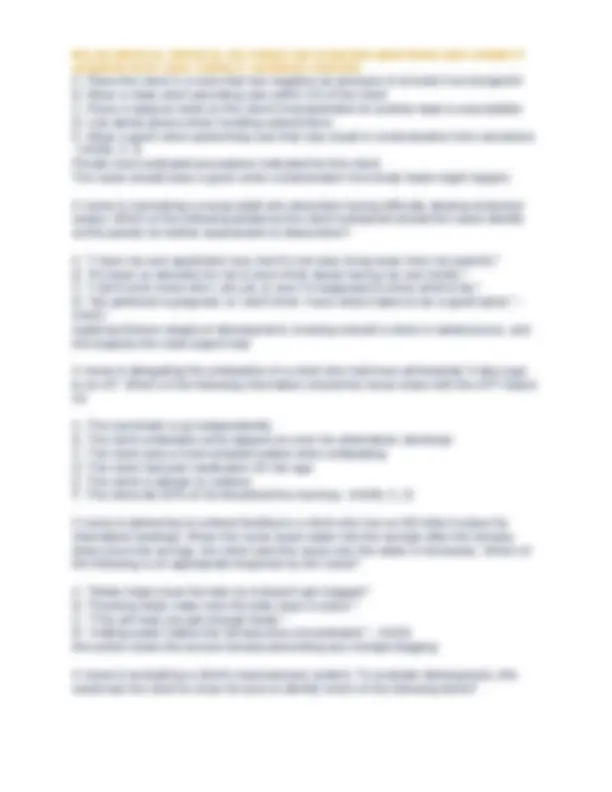
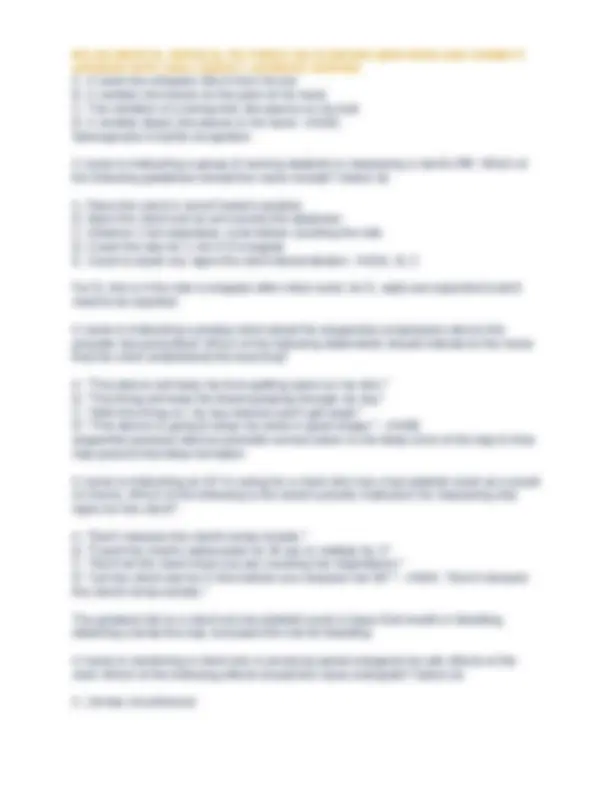
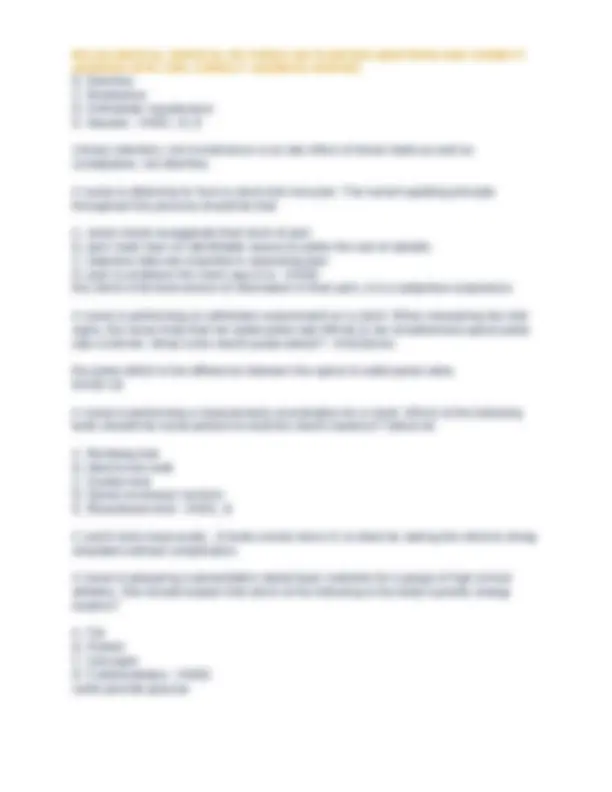
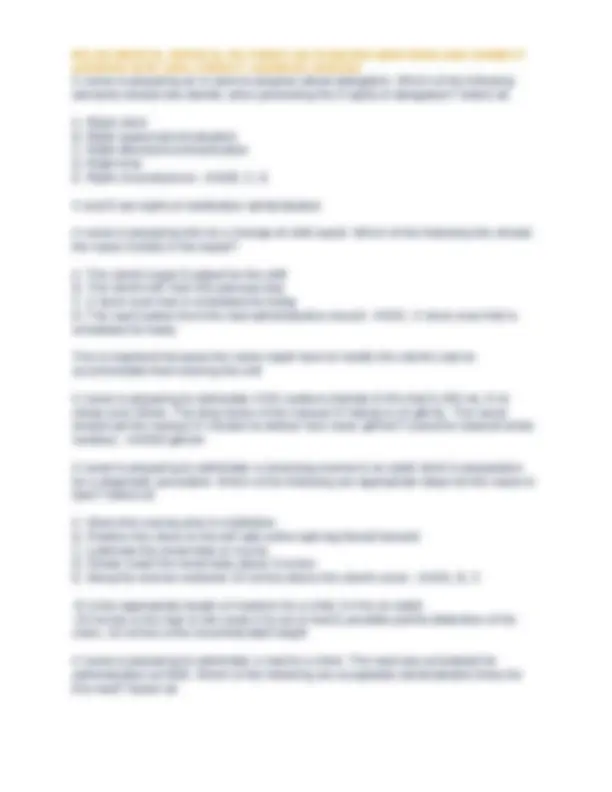
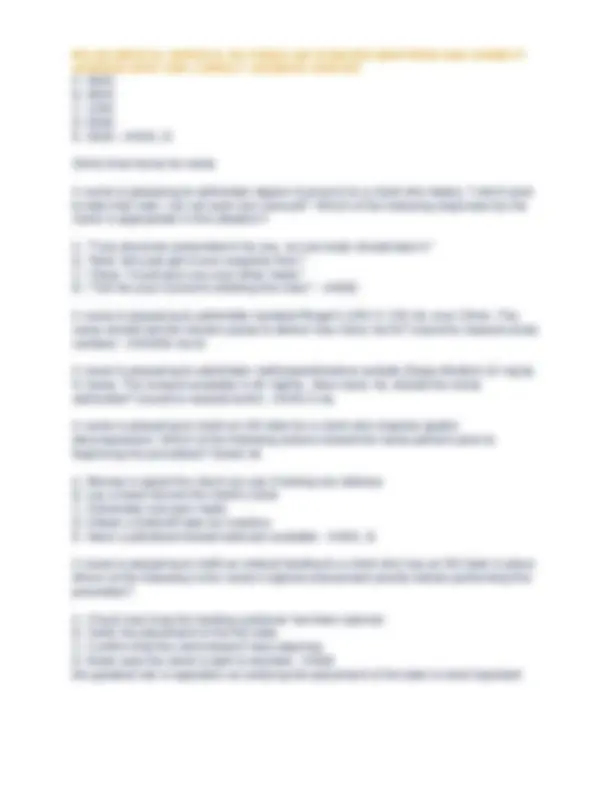
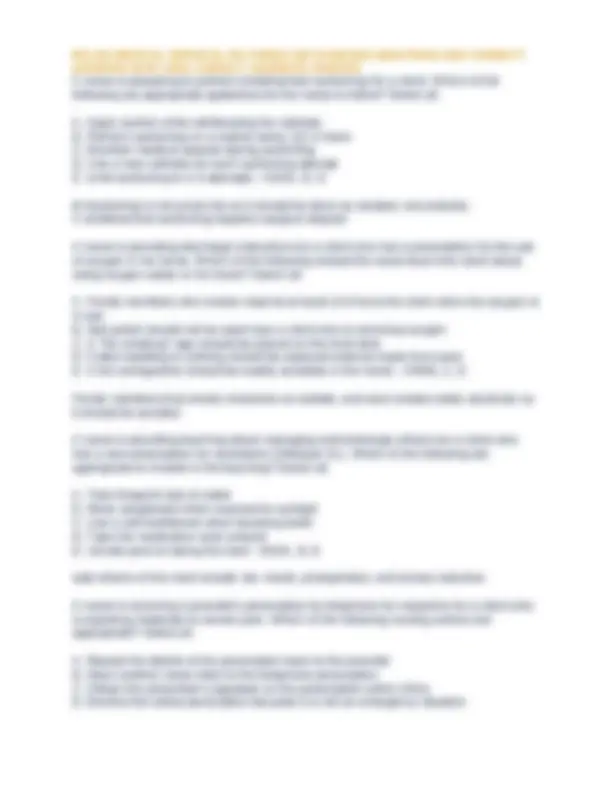
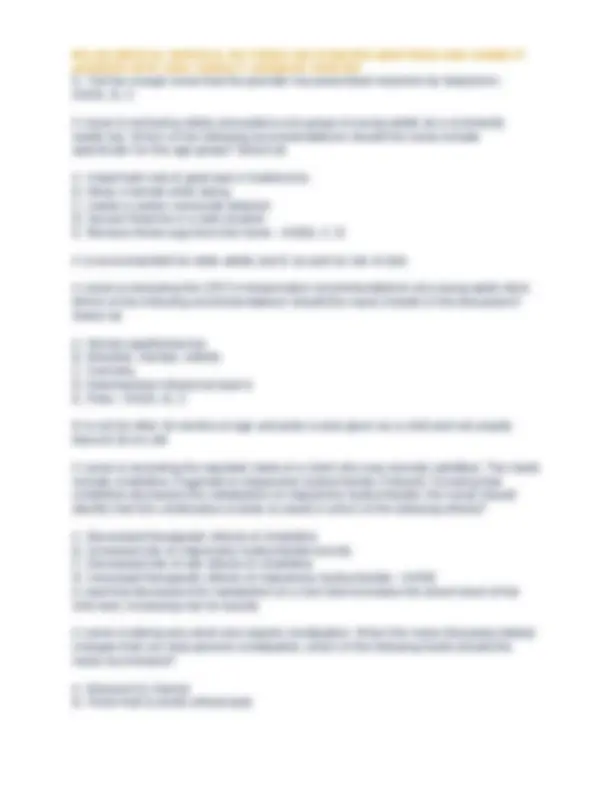
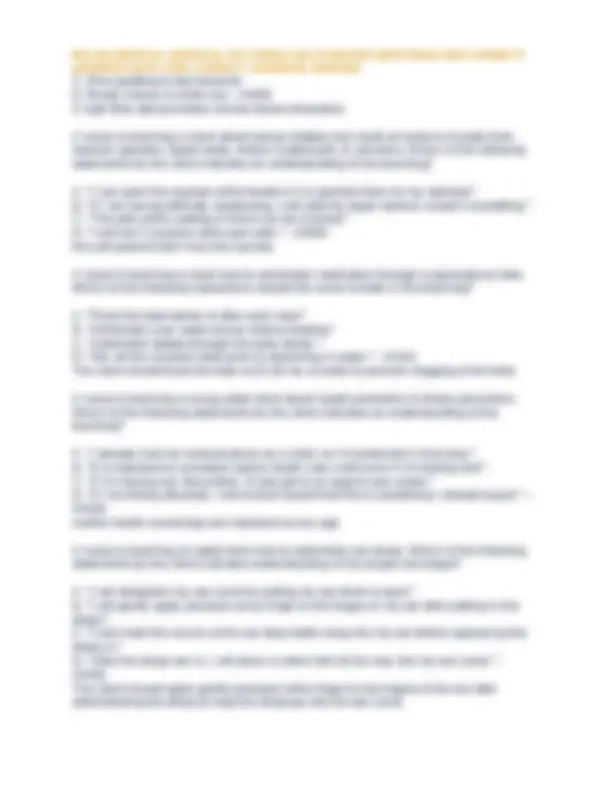
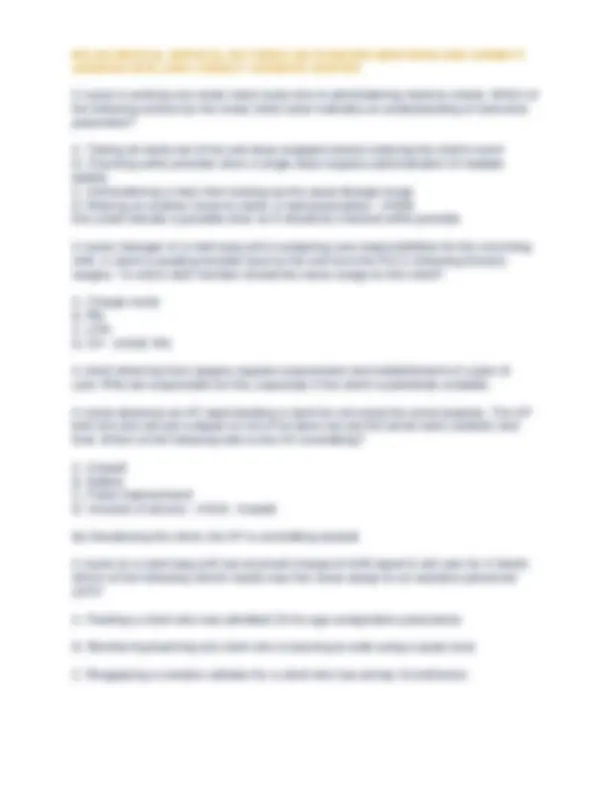
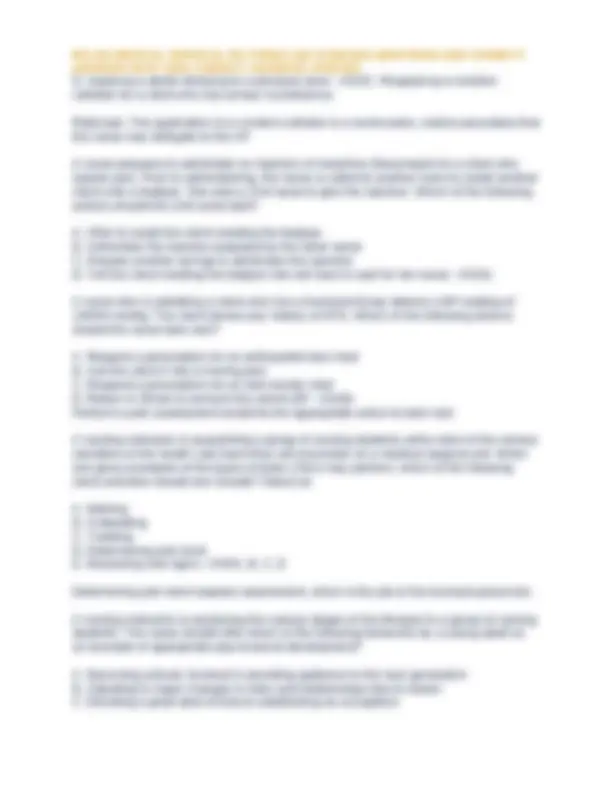
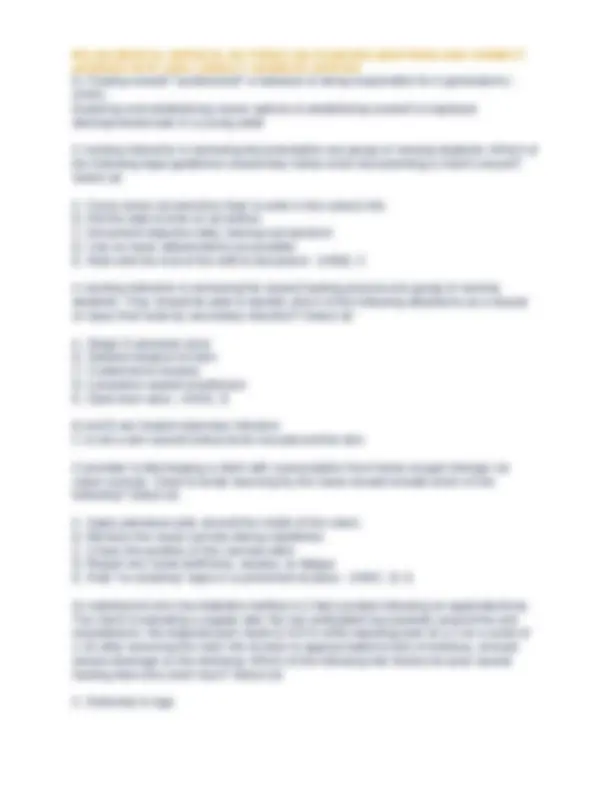
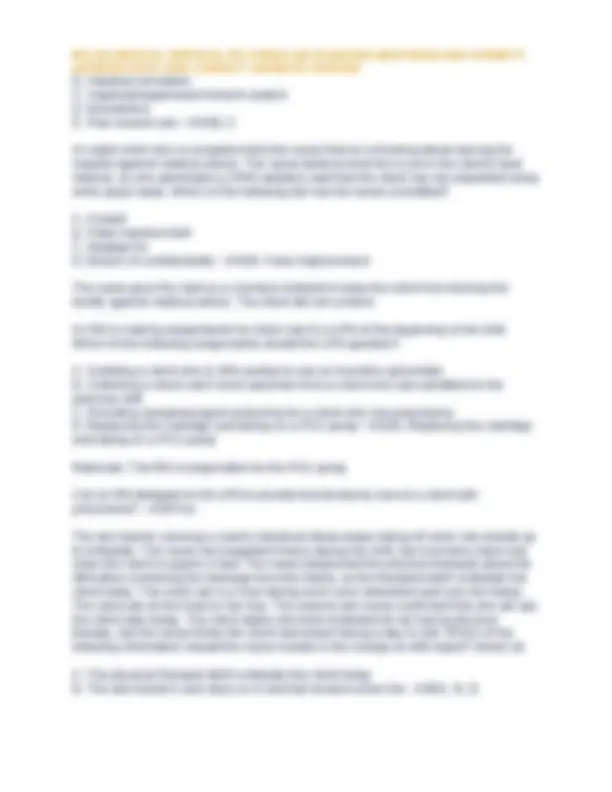
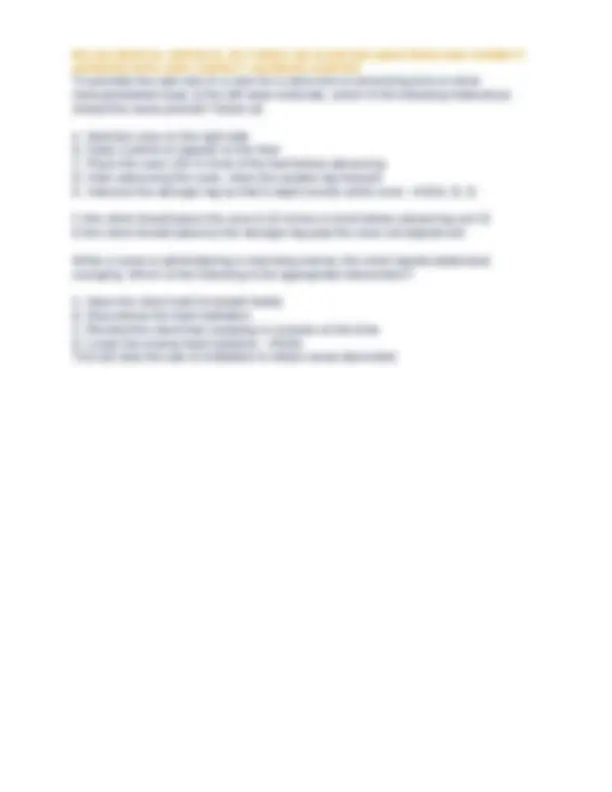


Study with the several resources on Docsity

Earn points by helping other students or get them with a premium plan


Prepare for your exams
Study with the several resources on Docsity

Earn points to download
Earn points by helping other students or get them with a premium plan
Community
Ask the community for help and clear up your study doubts
Discover the best universities in your country according to Docsity users
Free resources
Download our free guides on studying techniques, anxiety management strategies, and thesis advice from Docsity tutors
A series of questions and answers related to the relias medical surgical rn form a & b exam for the year 2023. The questions cover various topics such as consent, alternatives to surgery, speech-language pathology, pain management, public health, enteral feedings, and pertussis care. The answers are verified to be 100% correct.
Typology: Exams
1 / 30

This page cannot be seen from the preview
Don't miss anything!























ANSWERS WITH 100% CORRECT ANSWERS VERIFIED 102 - ANS 1.2 Milligrams is equal to how many micrograms - ANS1200 mcg a patient on warfarin(Coumadin/jantoven) has an INR of 6. Which medication would you anticipate administering? - ANSVitamin K A patient with diabetes who is receiving peritoneal dialysis Is at risk for which of the following? - ANS? After scrolling through your social media, you notice a coworker posted a photo with a patient from your unit. What is the most appropriate action to take? - ANSReport the situation to the hospital compliance officer. Black and tarry Colored stools are classic symptoms of what condition? - ANSBleeding gastric ulcer dietary teaching for a patient with chronic renal failure should include choices that are: - ANSLow potassium, low protein, moderate fat Failed to capture question - ANSFailed to capture answer Failed to capture question - ANSFailed to capture answer In addition to pain, pallor, and pulselssness, a neurovascular assessment Also includes checking for - ANSParasthesia and paralysis Is a patient with peritonitis Presents with tachycardia, hypotension , and dehydration. What other assessment finding would you anticipate as part of your physical assessment? - ANSSevere abdominal pain or rebound tenderness Is the provider gives you a telephone order to explain a surgical procedure to your patient and obtain surgical consent. How should you respond? - ANSInform the provider that explaining the procedure is outside the nurse's scope of practice. Is what is the earliest sign indicating increased intracranial pressure(ICP)? - ANSLevel of consciousness Is your patient with hepatitis C Exhibits signs of jaundice and a distended abdomen. What procedure would you anticipate being performed by the provider at the bedside for this patient? - ANSParacentesis Is your patient with stage IV Terminal lung cancer continues to experience increasing pain as each day passes. What would you anticipate the provider ordering for this patient? - ANSPalliative care consult
ANSWERS WITH 100% CORRECT ANSWERS VERIFIED Patients with diabetes are at a high risk for complications for damage in what body areas? - ANSNerve and kidney damage To reduce the risk of infection and phlebotomy in an adult patient with a peripherL IV, What is the minimum duration the catheter should remain in place before routine replacement. - ANS72 hours Upon entering your patient's room you note that they are having a seizure. What is your 1st action? - ANSPosition the patient on their side to maintain the airway Upon entry to your patient's room, you find her sitting in high Fowler's Position and complaining of shortness of breath. Her respiratory rate is 34 breaths/minute And 02 sat is 84%. Which mode of oxygen delivery would most likely reverse the symptoms? - ANSNon rebreather mask What are the most common causes of acute onset pancreatitis? - ANSAlcoholism and gallstones What is a proton pump inhibitor, such as pantoprazole (protonix) used for? - ANSReduce gastric acid secretion What is an early symptom that a patient is developing a complication of heart failure? - ANSEdema in the legs and feet What is clubbing of the fingers most likely associated with? - ANSChronic oxygen deficiency What is the best indication of an acute neurological problem? - ANSChange in level of consciousness What lab values are expected to be in a patient with end stage renal disease on hemodialysis - ANSBUN 32, CREATNINE 8. What medication is contraindicated In a patient with A hemorrhagic CVA? - ANSHeparin What patient population is the pneumococcal vaccine PPSV23 indicated for? - ANSAdults aged 65 years and older What type of personal protective equipment(Ppe) Is applied prior to entering a room for a patient with with C diff? - ANSGown and gloves When would sucralfate(Carafate) 4 times daily be scheduled for? - ANS1 hour before meals and at bedtime
ANSWERS WITH 100% CORRECT ANSWERS VERIFIED You were hired to work the medical unit and when you arrive at work the charge nurse has assigned you to the post surgical unit since they are under staffed. Which is the most appropriate action? - ANSReport to the post surgical unit You're patient Recently had a G Tube Placed and interminent enteral Feedings have been initiated. What symptoms may indicate intolerance to the feedings? - ANSVomiting and diarrhea Your 18 year old female patient was admitted with dehydration secondary to anorexia nervosa. During your assessment you note she has a flat effect and says" I just want to die, I'm tired of my life ". What should be your 1st intervention? - ANSStay with the patient and ask if she has a plan to carry out this wish Your 68 year old patient is a is a Type one diabetic with a history of schizophrenia And exhibit signs and symptoms of tardiness dyskinesia. Is what long term medication is associated with signs and symptoms of tardive dyskinesia? - ANSChlorpromazine(thorazine) Your 72 Year old male patient is admitted for colon cancer Related complications and has a history of CHF, stroke and a recent Knee replacement.Based on your patient's risk assessment,You determine he is at risk for Venous thromboembolism (VTE) What is an appropriate VTE prophylaxis prophylaxis order for this patient? - ANSEnoxaparin(Lovenox) once daily and intermittent pneumatic compressions(IPC) Your 85 year old patient with atrial fibrillation fell at home 3 days ago. You notice she has been having several episodes of acute confusion since being admitted to your unit. What is the most important order you should anticipate from the provider? You're? - ANSHold wayfaring (coumadin) for the next 48 hours Your coworker posted photos on social media from a birthday party they had for her in the unit break room. What should be your next course of action? - ANSNo action is necessary because no PHI was displayed. Your male patient complaints of discomfort while inflating the balloon during insertion of a endwelling urinary catheter. What would be the most appropriate action? - ANSDeflate the balloon, advance the catheter further, then reinflate the balloon. Your new admission presents with a cough, unintentional weight loss, frequent knot sweats, and bloody sputum. What type of isolation precautions should you initiate, if any? - ANSAirborne precautions Your new patient understands very limited English. How should you communicate with them when completing the admission assessment? - ANSUse the organizations interpreter services
ANSWERS WITH 100% CORRECT ANSWERS VERIFIED Your new patient was admitted with Blunt force trauma to the abdomen Following a motor vehicle accident. A NG Tube is in place for decompression, however, you note during the assessment that the stomach is rigid and hard during palpation. What condition do you suspect. - ANSHemorrhage Your patient appears dusky colored and you cannot palpate a pulse. What is the 1st thing you should do? - ANSInitiate a code per facility protocol and begin CPR Your patient continues to pull at their iv located in their left forearm despite verbal reminders And increased observation. The nursing assistant recommends using soft mitt Restraints on the patient. What is your recommendation? - ANSRequest and order for soft mitts As they are the least restrictive.. Your patient has a non productive cough and presence of secretions in his tracheostomy. Prior to sectioning the patient, what should you do 1st? - ANSHyperoxygenate patient Your patient has a temp of 102.3 F, HR 122, and has had 15ml of urine from the indwelling urinary catheter in the last 2 hours. What is your patient most likely experiencing? - ANS? Your patient has symptomatic anemia but is refusing a blood transfusion for religious reasons. What is an appropriate response? - ANSRespect his wishes and notify the provider Your patient is 4 hours post open appendectomy Anne has not voided yet. You note his lower abdomen is distended. What should you do next? - ANSPerform a bladder scan Your patient is admitted from the ED with failure to thrive and advanced dementia. You note he is extremely underweight, appears unbathed for some time, and has a stage 4 pressure injury to his coccyx. You were told in report that he lives at home with family members. What should you do? - ANSNotify the charge nurse and social worker of your concerns. Your patient is admitted with diverticulitis. What type of diet do you expect to be ordered for the patient? - ANSClear liquids Your patient is on contact precautions for active MRSA. What proper PPE should you use before entering the room? - ANSGown and gloves Your patient takes 5 mg of warfarin(coumadin) day and reports having black cored stool today. What do you most likely suspect? - ANSGastrointestinal bleeding Your patient takes regular insulin and NPH twice A-day for glucose control. What times should the patient be taught to be alert for signs of hypoglycemia? - ANSIs late afternoon and early morning
ANSWERS WITH 100% CORRECT ANSWERS VERIFIED A. Social worker B. CNA C. Occupational therapist D. Speech-language pathologist - ANSD A speech-language pathologist can initiate specific therapy for clients who have difficulty feeding due to swallowing difficulties A client who is postop following a knee arthroplasty is concerned about the adverse effects of the medication he is receiving for pain management. Which of the following members of the interprofessional care team may assist the client in understanding the medication's effects? Select all. A. Provider B. CNA C. Pharmacist D. RN E. Respiratory therapist - ANSA, C, D A client who will undergo neurosurgery the following week tells the nurse in the surgeon's office that he will prepare his advance directives before he goes to the hospital. Which of the following statements by the client indicates to the nurse that he understands advance directives? A. "I'd rather have my brother make decisions for me, but I know it has to be my wife." B. "I know they won't go ahead w/the surgery unless I prepare these forms." C. "I plan to write that I don't want them to keep me on a breathing machine." D. "I will get my regular doctor to approve my plan before I hand it in at the hospital." - ANSC. The client has the right to decide and specify which medical procedures he wants when a life-threatening situation arrives A goal for a client who has difficulty w/self-feeding due to rheumatoid arthritis is to use adaptive devices. The nurse caring for the client should initiate a referral w/which of the following members of the interprofessional care team? A. Social worker B. Certified nursing assistant C. Registered dietitian D. Occupational therapist - ANSD. An occupational therapist can assist clients who have physical challenges to use adaptive devices & strategies to help w/self-care activities A home health nurse is discussing the dangers of carbon monoxide poisoning w/a client. Which of the following information should the nurse include in her counseling? A. Carbon monoxide has a distinct odor
ANSWERS WITH 100% CORRECT ANSWERS VERIFIED B. Water heaters should be inspected every 5 years C. The lungs are damaged from carbon monoxide inhalation D. Carbon monoxide binds w/hemoglobin in the body - ANSD. Carbon monoxide is a very dangerous gas because it binds w/hemoglobin & ultimately reduces the oxygen supplied to the tissues in the body. Carbon monoxide is tasteless, has no scent, and cannot be seen. The water heaters, gas-burning furnances, and appliances should be inspected annually The lungs are not damaged in the process of inhalation A home health nurse is discussing the dangers of food poisoning w/a client. Which of the following info should the nurse include in her counseling? Select all. A. Most food poisoning is caused by a virus B. Immunocompromised individuals are at risk for complications from food poisoning C. Clients who are especially at risk are instructed to eat or drink only pasteurized milk, yogurt, cheese, or other dairy products D. Healthy individuals usually recover from the illness in a few weeks E. Handling raw & fresh food separately to avoid cross contamination may prevent food poisoning - ANSB, C, E Most food poisoning is caused by a bacteria such as E. coli. Healthy individuals usually recover in a few days. A nurse educator is conducting a parenting class for new parents. Which of the following statements made by a participant indicates a need for further clarification & instruction? A. "I will begin swimming lessons as soon as my baby can close her mouth under water." B. "Once my baby can sit up, he should be safe in the bathtub." C. "I will test the temp of the water before placing my baby in the bath." D. "Once my infant starts to push up, I will remove the mobile from over the bed." - ANSB Although the baby can hold his head above the water by sitting up, this does not make the baby safe in the tub. Parents should never leave a child unattended in a tub. A nurse educator is presenting a module on basic first aid for newly licensed home health nurses. The nurse educator evaluates the teaching as effective when the newly licensed nurse states the client who has heat stroke will have which of the following? A. Hypotension B. Bradycardia C. Clammy skin D. Bradypnea - ANSA. Hypotension Tachycardia, hot dry skin, and tachypnea are other manifestations of heat stroke
ANSWERS WITH 100% CORRECT ANSWERS VERIFIED By writing what the client states, the info is subjective data A nurse has noticed several occasions in the past week when another nurse on the unit seemed drowsy & unable to focus on the issue at hand. Today, she found the nurse asleep in a chair in the break room when she was not on break. Which of the following actions should the nurse take? A. Remind the nurse that safe client care is a priority on the unit B. Ask others on the team whether they have observed the same behavior C. Report observations to the nurse manager on the unit D. Conclude that her coworker's fatigue is not her problem to solve - ANSC. Any nurse who notices behavior that could possibly jeopardize client care or indicate a substance abuse problem has a duty to report the situation immediately to the nurse manager A nurse in a provider's office is preparing to assess a young adult male client's musculoskeletal system as part of a comprehensive physical examination. Which of the following findings should the nurse expect? Select all. A. A concave thoracic spine posteriorly B. An exaggerated lumbar curvature C. A concave lumbar spine posteriorly D. An exaggerated thoracic curvature E. Muscles slightly larger on his dominant side - ANSC, E A nurse in a senior center is counseling a group of older adults about their nutritional needs & considerations. Which of the following info should the nurse include? Select all. A. Older adults are more prone to dehydration than younger adults are B. Older adults need the same amount of most vitamins & minerals as younger adults do C. Many older men & women need calcium supplementation D. Older adults need more calories than they did when they were younger E. Older adults should consume a diet low in carbs - ANSA, B, C D-they need fewer calories not more E-they need more carbs & fiber A nurse in an outpatient clinic is caring for a client who states she is trying to get pregnant. The client currently takes a Category D pregnancy risk med for the control of seizures. Which of the following statements by the nurse is appropriate? A. "This med is prescribed if necessary but it is known to cause adverse effects to the fetus." B. "This med has evidence indicating that it is safe to take during pregnancy & will not harm the fetus."
ANSWERS WITH 100% CORRECT ANSWERS VERIFIED C. "This med cannot be taken during pregnancy because the risk outweighs the potential benefits." D. "This med hasn't been studied in pregnant women but is believed to be safe for the fetus." - ANSA. Category D meds are known to cause harm to fetuses, however the use during pregnancy may be warranted based on potential benefits. A nurse in an outpatient surgical center is admitting a client for a laproscopic procedure. The client has a prescription for preoperative diazepam (Valium). Prior to administering the med, which of the following actions is the highest priority? A. Teaching the client about the purpose of the med B. Administering the med to the client at the prescribed time C. Identifying the client's med allergies D. Documenting the client's anxiety level - ANSC. The greatest risk to the client is an allergic reaction to the med A nurse is assessing a client who has an acute resp. infection that puts her at risk for hypoxemia. Which of the following findings are early indications that should alert the nurse that the client is developing hypoxemia? Select all. A. Restlessness B. Tachypnea C. Bradycardia D. Confusion E. Pallor - ANSA, B, E C and D are late manifestations of hypoxemia. A nurse is assessing a client who is 5 days post op following abd. surgery. The surgeon suspects an incisional wound infection & has prescribed antibiotic therapy for the nurse to initiate after collecting wound & blood specimens for culture & sensitivity. Which of the following assessment findings should the nurse expect? Select all. A. Increase in incisional pain B. Fever & chills C. Reddened wound edges D. Increase in serosanguineous drainage E. Decrease in thirst - ANSA, B, C A nurse is assessing a client who is reporting severe pain despite analgesia. The nurse can best assess the intensity of the client's pain by: A. asking what precipitates the pain B. questioning the client about the location of the pain C. offering the client a pain scale to measure his pain
ANSWERS WITH 100% CORRECT ANSWERS VERIFIED Not D because endemic disease is already prevalent within a population, so reporting is not necessary A nurse is caring for a client in a long-term care facility who is receiving enteral feedings via NG tube. Which of the following is an appropriate nursing action prior to administering the tube feeding? Select all. A. Auscultate bowel sounds. B. Assist the client to an upright position. C. Test the pH of gastric aspirate. D. Warm the formula to body temp. E. Discard any residual gastric contents. - ANSA, B, C D-the formula should be room temp not body E-unless the volume of the contents is more than 250 mL, the nurse should return the residual content to the client's stomach A nurse is caring for a client who has a tracheostomy. Which of the following actions should the nurse take each time he provides tracheostomy care? Select all. A. Apply the oxygen source loosely if the SPO2 decreases during the procedure B. Use surgical asepsis to remove & clean the inner cannula C. Clean the outer surfaces in a circular motion from the stoma site onward D. Replace the tracheostomy ties w/new ties E. Cut a slit in gauze squares to place beneath the tube holder. - ANSA, B, C D-only replace ties if soiled or wet E-use a commercially prepared gauze w/slit not one nurse makes A nurse is caring for a client who has been sitting in a chair for 3 hrs. Which of the following problems is the client at risk for developing? A. Stasis of secretions B. Muscle atrophy C. Pressure ulcer D. Fecal impaction - ANSAnswer: C Unrelieved pressure over a bony prominence for too long increases the risk of a pressure ulcer A-sitting will help prevent stasis of secretions B and D-these are from prolonged bed rest A nurse is caring for a client who has had diarrhea for the past 4 days. When assessing the client, the nurse should expect which of the following findings? Select all.
ANSWERS WITH 100% CORRECT ANSWERS VERIFIED A. Bradycardia B. Hypotension C. Fever D. Poor skin turgor E. Peripheral edema - ANSB, C, D fever=caused by dehydration tachycardia not brady hypotension because of decreased BP from dehydration fluid overload=peripheral edema A nurse is caring for a client who is 1 day postop following a total knee arthroplasty. The client states his pain level is a 10 on a scale of 0-10. After reviewing the client's medication administration record, which of the following medications should the nurse administer? A. Meperidine (Demerol) 75 mg IM B. Fentanyl 50 mcg/hr transdermal patch C. Morphine 2 mg IV D. Oxycodone 10 mg PO - ANSC. IV morphine is the best because the onset is rapid and absorption to the blood is immediate, which is adequate for a client with a 10 pain severity A nurse is caring for a client who is at high risk for aspiration. Which of the following is an appropriate nursing intervention? A. Give the client thin liquids. B. Instruct the client to tuck her chin when swallowing. C. Have the client use a straw. D. Encourage the client to lie down & rest after meals. - ANSB. Tucking when swallowing allows food to pass down esophagus more easily. A nurse is caring for a client who is having difficulty breathing. The client is lying in bed & is already receiving oxygen therapy via nasal cannula. Which of the following interventions is the nurse's priority? A. Increase the oxygen flow B. Assist the client to Fowler's position C. Promote removal of pulmonary secretions D. Obtain a specimen for arterial blood gases - ANSB Fowler's facilitates better breathing A nurse is caring for a client who is on a low-residue diet. The nurse should expect to see which of the following foods on the client's meal tray? A. Cooked barley
ANSWERS WITH 100% CORRECT ANSWERS VERIFIED A nurse is caring for a client who presents w/linear clusters of fluid-containing vesicles w/some crustings. Which of the following should the nurse suspect? A. Allergic reaction B. Ringworm C. Systemic lupus erythematosus D. Herpes zoster - ANSD. Herpes zoster pink body rash=allergic reaction red circles w/white centers=ringworm red cheek rash bilaterally=lupus A nurse is caring for a client who reports severe sore throat, pain when swallowing, & swollen lymph nodes. The client is experiencing which of the following stages of infection? A. Prodromal B. Incubation C. Convalescence D. Illness - ANSD. Illness specific s/s present is the illness stage A nurse is caring for a client who weighs 80 kg (176 lb) and is 1.6 m ( 5 ft 3 in) tall. Calculate her BMI & determine whether this client is obese based on her BMI. - ANSBMI= above 30 equals obese so yes. A nurse is caring for a client who will perform fecal occult blood testing at home. Which of the following info should the nurse include when explaining the procedure to the client? A. Eating more protein is optimal prior to testing B. One stool specimen is sufficient for testing C. A red color change indicates a positive test D. The specimen cannot be contaminated - ANSD. The stool specimens cannot be contaminated with water or urine A nurse is caring for an 82-yr-old client in the ER who has an oral body temp of 38.3 C (101 F), a pulse rate of 114/min, & a RR of 22/min. He is restless & his skin is warm. Which of the following are appropriate nursing interventions for this client? Select all. A. Obtain culture specimens before initiating antimicrobials B. Restrict the client's oral fluid intake C. Encourage the client to limit activity & rest D. Allow the client to shiver to dispel excess heat
ANSWERS WITH 100% CORRECT ANSWERS VERIFIED E. Assist the client w/oral hygiene frequently - ANSA, C, E The nurse should prevent shivering & encourage the client to increase fluids. Why E-Oral hygiene helps prevent cracking of dry mucous membranes of the mouth & lips. A nurse is caring for an older adult client who is at risk for developing pressure ulcers. Which of the following interventions should the nurse use to help maintain the integrity of the client's skin? Select all. A. Keep the head of the bed elevated 30 degrees B. Massage the client's bony prominences often C. Apply cornstarch liberally to the skin after bathing D. Have the client sit on a gel cushion when in a chair E. Reposition the client at least Q 3 hr while in bed - ANSA, D not E because it should be at least every 2 hours A nurse is caring for an older adult client who lives alone & is to be discharged in 3 days. He states that it is difficult to prepare adequate nutritious meals at home for just 1 person. To which of the following members of the health care team should the nurse refer him? A. Registered dietitian B. Occupational therapist C. Physical therapist D. Social worker - ANSD. social worker A social worker can make arrangements for a meal delivery service to provide nutritious meals daily, or recommend a congregate meal site near the client's home A nurse is collecting data from an older adult client as part of a neurosensory examination. Which of the following findings should the nurse expect as changes associated w/aging? Select all. A. Slower light touch sensation B. Some vision & hearing decline C. Slower fine finger movement D. Some short-term memory decline E. Slower superficial pain sensation - ANSB, C, D A nurse is contributing to the plan of care for a client who is being admitted to the facility w/a suspected diagnosis of pertussis. Which of the following should the nurse include in the plan of care? Select all.
ANSWERS WITH 100% CORRECT ANSWERS VERIFIED A. A word she whispers 30cm from his ear B. A number she traces on the palm of his hand C. The vibration of a tuning fork she places on his foot D. A familiar object she places in his hand - ANSD. Stereognosis is tactile recognition A nurse is instructing a group of nursing students in measuring a client's RR. Which of the following guidelines should the nurse include? Select all. A. Place the client in semi-Fowler's position B. Have the client rest an arm across the abdomen C. Observe 1 full respiratory cycle before counting the rate D. Count the rate for 1 min if it is regular E. Count & report any signs the client demonstrates - ANSA, B, C For D, this is if the rate is irregular after initial count, for E, sighs are expected & don't need to be reported A nurse is instructing a postop client about the sequential compression device the provider has prescribed. Which of the following statements should indicate to the nurse that the client understands the teaching? A. "This device will keep me from getting sores on my skin." B. "This thing will keep the blood pumping through my leg." C. "With this thing on, my leg muscles won't get weak." D. "This device is going to keep my joints in good shape." - ANSB. sequential pressure devices promote venous return in the deep veins of the legs & thus help prevent thrombus formation A nurse is instructing an AP in caring for a client who has a low platelet count as a result of chemo. Which of the following is the nurse's priority instruction for measuring vital signs for this client? A. "Don't measure the client's temp rectally." B. "Count the client's radial pulse for 30 sec & multiply by 2." C. "Don't let the client know you are counting her respirations." D. "Let the client rest for 5 mins before you measure her BP." - ANSA. "Don't measure the client's temp rectally." The greatest risk to a client w/a low platelet count is injury that results in bleeding, obtaining a temp this way increases the risk for bleeding. A nurse is monitoring a client who is receiving opioid analgesia for adv effects of the med. Which of the following effects should the nurse anticipate? Select all. A. Urinary incontinence
ANSWERS WITH 100% CORRECT ANSWERS VERIFIED B. Diarrhea C. Bradypnea D. Orthostatic hypotension E. Nausea - ANSC, D, E Urinary retention, not incontinence is an adv effect of these meds as well as constipation, not diarrhea. A nurse is obtaining hx from a client who has pain. The nurse's guiding principle throughout this process should be that: A. some clients exaggerate their level of pain B. pain must have an identifiable source to justify the use of opioids. C. objective data are essential in assessing pain D. pain is whatever the client says it is - ANSD the client is the best source of information in their pain, it is a subjective experience A nurse is performing an admission assessment on a client. When measuring her vital signs, the nurse finds that her radial pulse rate 68/min & her simultaneous apical pulse rate is 84/min. What is the client's pulse deficit? - ANS16/min the pulse deficit is the difference between the apical & radial pulse rates. 84-68= A nurse is preforming a neurosensory examination for a client. Which of the following tests should the nurse preform to test the client's balance? Select all. A. Romberg test B. Heel-to-toe walk C. Snellen test D. Spinal accessory function E. Rosenbaum test - ANSA, B C and E test visual acuity , D tests cranial nerve XI is intact by asking the client to shrug shoulders without complication. A nurse is preparing a presentation about basic nutrients for a group of high school athletes. She should explain that which of the following is the body's priority energy reserve? A. Fat B. Protein C. Glycogen D. Carbohydrates - ANSD. carbs provide glucose